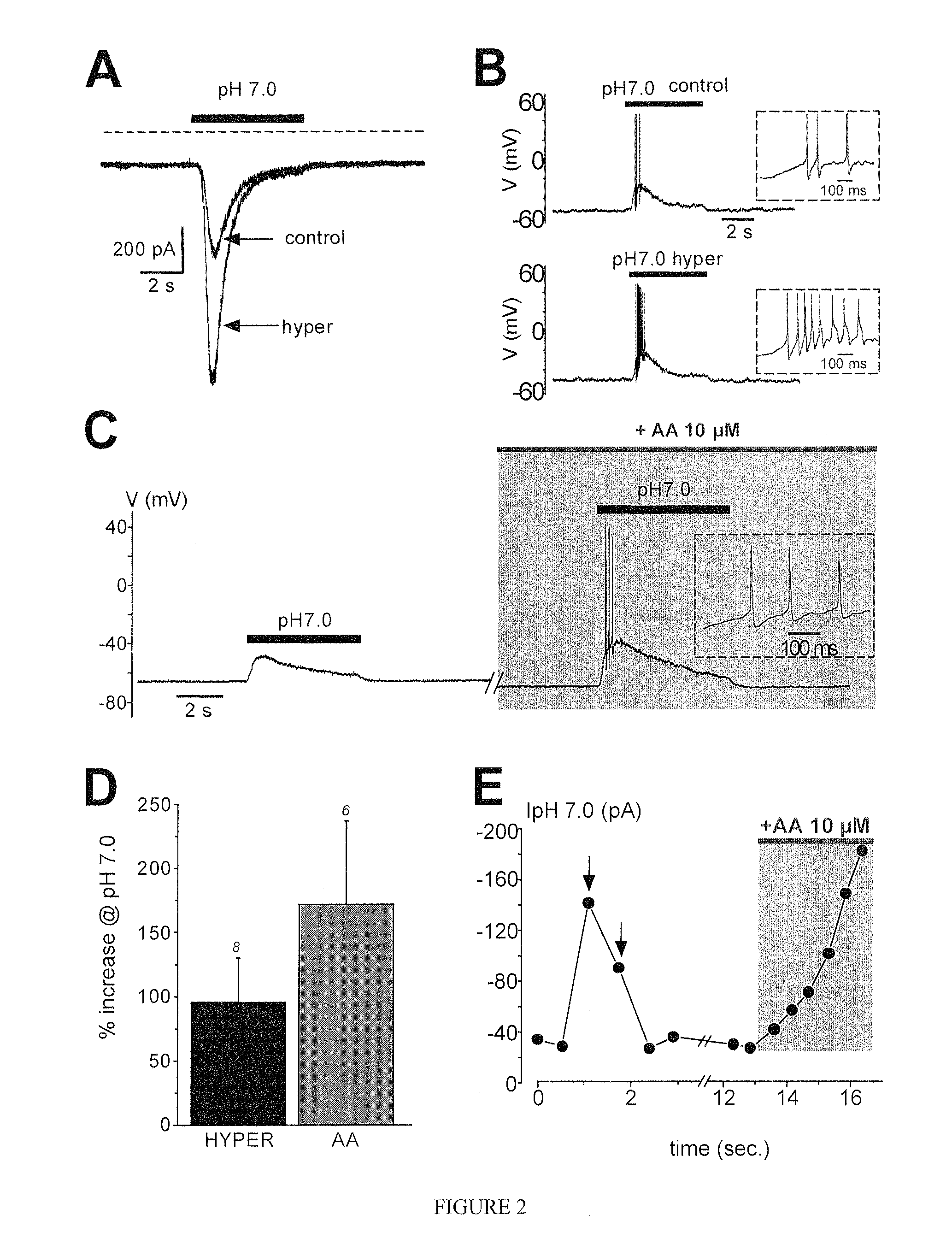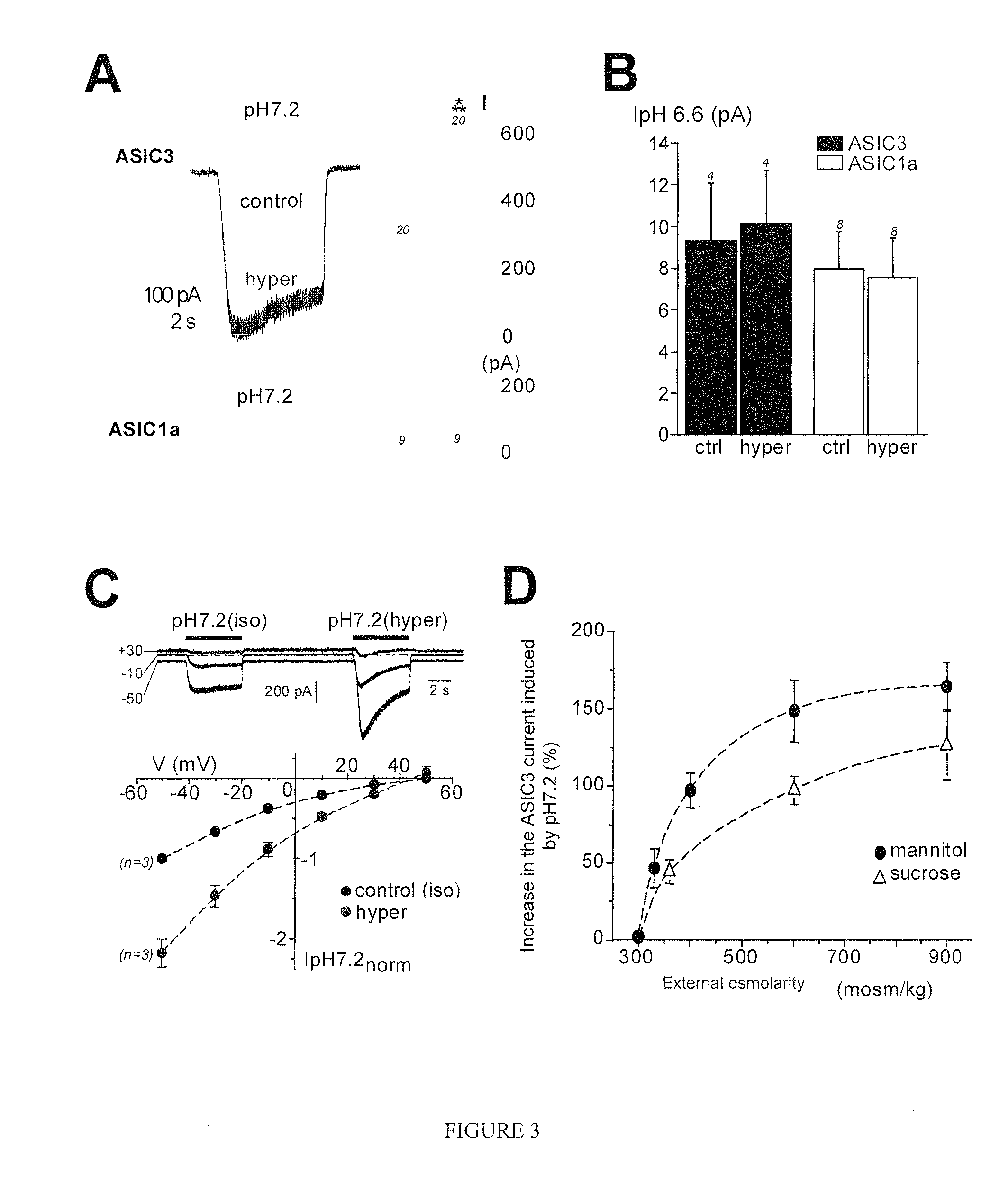Analgesic effects of peptide toxin apetx2
a peptide toxin and analgesic effect technology, applied in the field of apetx2 peptide toxin, can solve problems such as unsatisfactory side effects, and achieve the effect of fewer or no undesirable side effects and convenient us
- Summary
- Abstract
- Description
- Claims
- Application Information
AI Technical Summary
Benefits of technology
Problems solved by technology
Method used
Image
Examples
example 1
Material and Method
[0031]Purification of the APETx2 Peptide Toxin of the Sea Anemone Anthopleura elegantissima
[0032]A polypeptide pool was isolated from a raw hydroalcoholic extract (water-methanol) of the sea anemone Anthopleura elegantissima ([ref. 39]), quoted above) by cation exchange chromatography on QAE Sephadex A-25 (4.5×400 nm) eluted with ammonium acetate (pH 8.3), followed by exclusion diffusion chromatography on Sephadex G50 (12×140 cm) in 1M acetic acid.
[0033]Six fractions were tested on ASIC3 channels expressed in Xenopus oocytes ([ref. 41], quoted above). One fraction, having inhibited more than 80% of the ASIC3 current, was purified by reversed-phase high performance liquid chromatography (HPLC) (Waters Symmetry C18, 4.6×250 mm), with a linear gradient of 10 to 40% of solvent B (acetonitrile / 0.1% TFA) for 30 min. at 1 ml / min. Separation was performed on a HP1100 system (Hewlett Packard, USA) coupled to a diode array detector with UV absorbance reading at 220 and 280...
example 2
ASIC3 Type Current in the Neurons of the Spinal Ganglia Innervating the Skin
[0047]The ASIC currents activated by moderate extracellular acidifications were recorded in the neurons of the spinal ganglia innervating the skin in rats and were identified by retrograde labelling using the Dil fluorescent dye (FIG. 1).
[0048]The moderate pH values used in these experiments (i.e. pH 6.6 and pH 7.0) were chosen in order to mainly activate the ASIC1 and ASIC3 type currents, owing to the fact that the ASIC2 and TRPV1 type currents had been described as being activated by more drastic acidification ([ref. 49] and [ref. 2], quoted above).
[0049]FIG. 1A shows a typical Dil-positive cutaneous neuron of the spinal ganglia (arrow) used for the patch clamp experiments in whole cell configuration. These neurons have a resting membrane potential of −55.0±1.8 mV and a membrane capacitance of 39.6±1.8 pF (n=42 and 43 neurons, respectively, with data from four different cultures).
[0050]FIG. 1B shows that 6...
example 3
Potentiation by Two Inflammatory Stimuli, Osmotic Pressure and Arachidonic Acid, of Asic Current of Cutaneous Neurons of the Spinal Ganglia Activated by Moderate Acidification
[0054]In damaged or inflamed tissues, several potential mediators are to be found in the interstitial fluid and form an inflammatory exsudate ([ref. 50]), the content of which is acid and hyperosmotic ([ref. 51]). Consequently, the effect of hyperosmolarity on ASIC currents of cutaneous neurons of the spinal ganglia activated by moderate acidification was studied.
[0055]FIGS. 2A, 2D and 2E show that hyperosmolarity, concomitantly applied with external moderate acidification (pH 7.0, refer to arrows in FIG. 2E), is capable of markedly increasing the ASIC type current induced by pH 7.0 in these neurons (an increase of 95%±35%, n=8, P<0.01, Student's paired t test) resulting in an increase in neuronal excitability by inducing more action potentials (FIG. 2B).
[0056]A positive effect of the inflammatory mediator, ara...
PUM
| Property | Measurement | Unit |
|---|---|---|
| pH | aaaaa | aaaaa |
| pH | aaaaa | aaaaa |
| pH | aaaaa | aaaaa |
Abstract
Description
Claims
Application Information
 Login to View More
Login to View More - R&D
- Intellectual Property
- Life Sciences
- Materials
- Tech Scout
- Unparalleled Data Quality
- Higher Quality Content
- 60% Fewer Hallucinations
Browse by: Latest US Patents, China's latest patents, Technical Efficacy Thesaurus, Application Domain, Technology Topic, Popular Technical Reports.
© 2025 PatSnap. All rights reserved.Legal|Privacy policy|Modern Slavery Act Transparency Statement|Sitemap|About US| Contact US: help@patsnap.com



